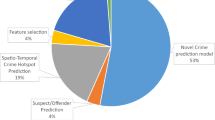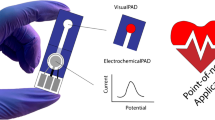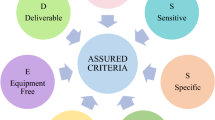Abstract
Gunshot Residue (GSR) has been a subject of interest for the forensic fraternity. Numerous analytical contributions towards the GSR analysis have been reported. Sensitivity, portability, cost-effectiveness, speed, etc. are such factors of electrochemical methods that have attracted the researchers across the globe to test the applicability of these as a potential analytical tool for forensic evaluation of GSR. With the development of scientific technology, efforts have been made towards the hand-held device for the on-field analysis of GSR. Recently, chemometric treatment of data generated from the electrochemical analysis of GSR has offered more effective approach. It makes the analysis more conclusive and minimizes the chances of false-positive detection. It will be very fruitful to anticipate the analytical potential of electrochemical tools for GSR analysis. This article reviews the research progress towards the development of electrochemical sensor for GSR detection reported during 2013–2020 along with challenges and future perspectives.


Similar content being viewed by others
References
Romolo FS, Margot P. Identification of gunshot residue: a critical review. Forensic Sci Int. 2001;119:195.
Brozek-Moucha Z. Trends in analysis of gunshot residue for forensic purpose. Anal Bioanal Chem. 2017;409(25):5803.
Brozek-Mucha Z. Distribution and properties of gunshot residue originating from a Luger 9 mm ammunition in the vicinity of the shooting gun. Forensic Sci Int. 2009;183:33.
Feeney W, Pyl CV, Bell S, Trejos T. Trends in composition, collection, persistence, and analysis of IGSR and OGSR: a review. Forensic Chem. 2020;19:100250.
Wallace JS. Chemical analysis of firearms. Boca Raton, London, New York: Ammunition and Gunshot Residue. CRC Press; 2008.
Walker JT. Bullet holes and chemical residues in shooting cases bullet holes and chemical residues in shooting cases. J Criminal Law Criminol. 1941; 31(4).
Harrison H, Gilroy R (1959) Firearm discharge residue. J Forensic Sci 184 (4).
Brozek-Mucha Z. Chemical and morphological study of gunshot residue persisting on the shooter by means of scanning electron microscopy and energy dispersive x-ray spectrometry. Microsc Microanal. 2011;7:972.
Chohra M, Beladel B, Ahmed BL, Mouzai M, Akretche D, Zeghdaoui A, Mansouri A, Benamar MEA. Study of gunshot residue by NAA and ESEM/EDX using several kinds of weapon and ammunition. J Radiation Res Appl Sci. 2015;8:404.
Kazimirov VI, Zorin AD, Zanozina VF. Application of x-ray fluorescence analysis to investigation of the composition of gunshot residues. J Appl Spectrosc. 2006;73(3):359.
Romolo FS, Christopher ME, Donghi M, Ripani L, Jeynes C, Webb RP, Ward NI, Krickby KJ, Bailey MJ. Integrated ion beam analysis (IBA) in Gunshot Residue (GSR) characterization. Forensic Sci Int. 2013;231(1–3):219.
Vanini G, Destefani CA, Merlo BB, Carneiro MTWD, Filgueiras PR, Poppi RJ, Romão W. Forensic ballistics by inductively coupled plasma-optical emission spectroscopy: Quantification of gunshot residues and prediction of the number of shots using different firearms. Microchem J. 2015;118:19.
ASTM E1588-17. Standard Practice for Gunshot Residue Analysis by Scanning Electron Microscopy/Energy Dispersive X-Ray Spectrometry. ASTM International, West Conshohocken, PA, 2017. DOI: https://doi.org/10.1520/E1588-17
Leggett LS, Lott PF. Gunshot Residue analysis via organic stabilizers and nitrocellulose. Microchem J. 1989;39:76.
Taudte RV, Roux C, Bishop D, Blanes L, Doble P, Beavis A. Development of a UHPLC method for the detection of organic gunshot residues using artificial neural networks. Anal Methods. 2015;7:747.
Tarifa A, Almirall JR. Fast detection and characterization of organic and inorganic gunshot residues on the hands of suspects by CMV-GC–MS and LIBS. Sci Justice. 2015;55(3):168.
Taudte RV, Beavis A, Blanes L, Cole N, Doble P, Roux C. Detection of Gunshot residues using mass spectrometry. Bio Med Res Int. 2014; 965403.
Williamson R, Gura S, Tarifa A, Almirall JR. The coupling of capillary microextraction of volatiles (CMV) dynamic air sampling device with DART-MS analysis for the detection of gunshot residues. Forensic Chem. 2018;8:49.
Mou Y, Lakadwar J, Rabalais JW. Evaluation of shooting distance by AFM and FTIR/ATR analysis of GSR. J Forensic Sci. 2008;53(6):1381.
Goudsmits E, Sharples GP, Birkett JW. Recent trends in organic gunshot residue analysis. TrAC. 2015;74:46.
Doty KC, Lednev IK. Raman spectroscopy for forensic purposes: recent applications for serology and gunshot residue analysis. TrAC. 2018;103:215.
Morales EB, V´azquez ALR. Simultaneous determination of inorganic and organic gunshot residues by capillary electrophoresis. Journal of Chromatography A. 2004; 1061: 225.
Gandy L, Najjar K, Terry M, Bridge C. A novel protocol for the combined detection of organic, inorganic gunshot residue. Forensic Chem. 2018;8:1.
Goudsmits E, Blakey LS, Chana K, Sharples GP, Birkett JW. The analysis of organic and inorganic gunshot residue from a single sample. Forensic Sci Int. 2019;299:168.
Trejos T, Pyl CV, Menking-Hoggatt K, Alvarado AL, Arroyo LE. Fast identification of inorganic and organic gunshot residues by LIBS and electrochemical methods. Forensic Chem. 2018;8:146.
Tsiatis N. A twenty-year review of firearms calibers used in offences against human life in Greece. AFTE J. 2016;48(2):92.
Khoshnood A. The increase of firearm-related violence in Sweden. Forensic Sci Res. 2017;2(3):158.
Khoshnood A. Firearm-related violence in Sweden: a systematic review. Aggress Violent Beh. 2018;42:43.
Morgan A, Aqil NA, AlOkeil NA, Ghaleb SA, Otaibi AF, Alashqar HM, Ghuwainem SOA, Qahtani MAM. Firearm injuries in rural Saudi Arabia: incidence, patterns, management, and cost. Egypt J Forensic Sci. 2019;9:1.
Mattijssen EJAT. Interpol review of forensic firearm examination 2016–2019. Forensic Sci Int. 2020. https://doi.org/10.1016/j.fsisyn.2020.01.008.
National Crime Record Bureau (NCRB), Ministry of home Affairs, Govt. of India, Crime in India 2018 (2019). http://ncrb.gov.in/sites/default/files/Crime%20in%20India%202018%20-%20Volume%201.pdf
National Crime Record Bureau (NCRB), Ministry of home Affairs, Govt. of India, Crime in India 2017 (2019). http://ncrb.gov.in/sites/default/files/Crime%20in%20India%202017%20-%20Volume%201_0.pdf.
National Crime Record Bureau (NCRB), Ministry of home Affairs, Govt. of India, Crime in India 2016, (2017).
National Crime Record Bureau (NCRB), Ministry of home Affairs, Govt. of India, Crime in India 2015, (2016).
de Oliveira LP, Rocha DP, de Araujo WR, Munoz RAA, Paixão TRLC, Salles MO. Forensics in hand: new trends in forensic devices (2013–2017). Anal Methods. 2018;10:5135.
Yáñez-Sedeño P, Agüí L, Campuzano S, Pingarrón JM. What electrochemical biosensors can do for forensic science? Unique Features Appl Biosens. 2019;9:127.
Shaw L, Dennany L. Applications of electrochemical sensors: forensic drug analysis. Curr Opin Electrochem. 2017;3:23.
Florea A, de Jong M, De Wael K. Review article electrochemical strategies for the detection of forensic drugs. Curr Opin Electrochem. 2018;11:34.
Barfidokh A, Mishra RK, Seenivasan R, Liua S, Hubble LJ, Wang J, Hall DA. Wearable electrochemical glove-based sensor for rapid and on-site detection of fentanyl. Sens Actuat. 2019;296:126422.
Mishra RK, Sempionatto JR, Li Z, Brown C, Galdino NM, Shah R, Liu S, Hubble LJ, Bagot K, Tapert S, Wang J. Simultaneous detection of salivary Δ9-tetrahydrocannabinol and alcohol using a wearable electrochemical ring sensor. Talanta. 2020;211:120757.
Mendes LF, Rodrigues Â, Silva SE, Bacil RP, Serrano SHP, Angnes L, Paixão TRLC, de Araujo WR. Forensic electrochemistry: electrochemical study and quantification of xylazine in pharmaceutical and urine samples. Electrochim Acta. 2018;295:726.
Sempionatto JR, Mishra RK, Martín A, Tang G, Nakagawa T, Lu X, Campbell AS, Lyu KM, Wang J. Wearable ring-based sensing platform for detecting chemical threats. ACS Sens. 2017;10(2):1531.
Gooch J, Daniel B, Parkin M, Frascione N. Developing aptasensors for forensic analysis. Trends Anal Chem. 2017;94:150.
Yu HA, DeTata DA, Lewis SW, Silvester DS. Recent developments in the electrochemical detection of explosives: towards field-deployable devices for forensic science. Trends Anal Chem. 2017;97:374.
de Araujo WR, Cardoso TMG, da Rocha RG, Santana MHP, Muñoz RAA, Richter EM, Paixão TRLC, Coltro WKT. Portable analytical platforms for forensic chemistry: a review. Anal Chim Acta. 2018;1034:1.
O’Mahony AM, Wang J. Electrochemical detection of gunshot residue for forensic analysis: a review. Electroanalysis. 2013;25(6):1341.
Smith JP, Randviir EP, Banks CE (eds). An introduction to forensic electrochemistry (2016). In: E. Katz, J. Halamek, Forensic Science: A Multidisciplinary Approach, (2016) Wiley-VCH Verlag GmbH& co. KGaA. DOI: https://doi.org/10.1002/9783527693535.ch5
Skoog DA, Holler FJ, Crouch SR. Principles of instrumental analysis. USA: Cengage Learning; 2006.
Janata J. Principle of Chemical Sensors, 2nd ed. Springer Boston, MA, 2009. DOI: https://doi.org/10.1007/b136378
Wen W. Introductory chapter: What is chemical sensor? INTECH. 2016. https://doi.org/10.5772/64626.
Power AC, Morrin A. Electroanalytical sensor techonology. INTECH. 2013. https://doi.org/10.5772/51480.
Lubert KH, Kalcher K. History of electroanalytical methods. Electroanalysis. 2010;22:1937–46. https://doi.org/10.1002/elan.201000087.
Stradiotto NR, Yamanaka H, Zanoni MVB. Electrochemical sensors: a powerful tool in analytical chemistry. J Braz Chem Soc. 2003;14(2):159.
Scozzari A (2008) Electrochemical sensing methods a brief review. In: Evangelista V, Barsanti L, Frassanito AM (eds) Algal toxins: nature, occurrence, effect and detection (NATO science for peace and security series A: chemistry and biology). Milan: Springer, (2008). Doi: https://doi.org/10.1007/978-1-4020-8480-5_16.
Konanur NK, Van Loon GW. Determination of lead and antimony in firearms discharge residues on hands by anodic stripping voltammetry. Talanta. 1977;24:184.
Liu JH, Lin W. The application of anodic stripping voltammetry to Forensic science. I. The construction of a low-cost polarograph. Forensic Sci Int. 1980;16:43.
Liu JH, Lin W, Nicol JD. The application of anodic stripping voltammetry to Forensic science. II. Anodic stripping voltammetric analysis of Gunshot Residues. Forensic Sci Int. 1980;16:53.
Brihaye C, Machiroux R, Gillian G. Gunpowder residues detection by anodic stripping voltammetry. Forensic Sci Int. 1982;20:269.
Jauhari M, Rao MS, Chattopadhyay N, Chatterjee SM, Sen A. Shooter identification: elemental analysis of swabbing materials by neutron activation analysis (NAA) and anodic stripping voltammetry (ASV). Forensic Sci Int. 1985;28:175.
Briner RC, Chouchoiy S, Webster RW, Popham RE. Anodic stripping voltammetric determination of antimony in gunshot residue. Anal Chim Acta. 1985;172:31.
Woolever CA, Starkey DE, Dewald HD. Differential pulse anodic stripping voltammetry of lead and antimony in gunshot residues. Forensic Sci Int. 1999;102:45.
Bohannan E, Van Galen D. A sensitive electrochemical method for the analysis of nitrite ion and metals in Gunshot Residue. J Forensic Sci. 1991;36(3):886.
Woolever CA, Dewald HD. Differential pulse anodic stripping voltammetry of barium and lead in gunshot residues. Forensic Sci Int. 2001;117:185.
Bratin K, Kissinger PT. Determination of nitro aromatic, nitramine, and Nitrate ester explosive compounds in explosive mixtures and gunshot residue by liquid chromatography and reductive electrochemical detection. Anal Chim Acta. 1981;130:295.
Dahl DB, Lott PF. Gunshot residue determination by means of gunpowder stabilizers using high-performance liquid chromatography with electrochemical detection and analysis of metallic residues by graphite furnace atomic absorption spectrophotometry. Microchem J. 1987;35:347.
Wang J, Lu F, MacDonald D, Lu J, Ozsoz MES, Rogers KR. Screen-printed voltammetric sensor for TNT. Talanta. 1998;46:1405.
Vuki M, Shiu K, Galik M, O’Mahony AM, Wang J. Simultaneous electrochemical measurement of metal and organic propellant constituents of gunshot residues. Analyst. 2012;137:3265.
De DA, Gutz IGR. Fast mapping of gunshot residues by batch injection analysis with anodic stripping voltammetry of lead at the hanging mercury drop electrode. Electroanalysis. 2005;17(2):105.
Rodriguez JA, Ibarra IS, Galan-Vidal CA, Vega M, Barrado E. Multicommutated anodic stripping voltammetry at tubular bismuth film electrode for lead determination in Gunshot Residues. Electroanalysis. 2009;21:452.
Erden S, Durmus Z, Kilic E. Simultaneous determination of antimony and lead in gunshot residue by cathodic adsorptive stripping voltammetric methods. Electroanalysis. 1967;2011:23.
Galik M, O’ Mahony AM, Wang J. Cyclic and square-wave voltammetric signatures of nitro- containing explosives. Electroanalysis. 2011;23(5):1193.
Salles MO, Bertotti M, Paixão TRLC. Use of a gold microelectrode for discrimination of gunshot residues. Sensors and Actuators B. 2012; 166.
Salles MO, Naozuka J, Bertotti M. A forensic study: lead determination in gunshot residues. Microchem J. 2012;101:49.
Cetó X, O_Mahony AM, Samek IA, Windmiller JR, Wang J (2012) Rapid field identification of subjects involved in firearm-related crimes based on electroanalysis coupled with advanced chemometric data treatment. Anal Chem. 84: 10306.
O’Mahony AM, Windmiller JR, Samek IA, Bandodkar AJ, Wang J. “Swipe and Scan”: Integration of sampling and analysis of gunshot metal residues at screen-printed electrodes. Electrochem Commun. 2012;23:52.
Bandodkar AJ, O’Mahony AM, Ramírez J, Samek IA, Anderson SM, Windmiller JR, Wang J. Solid-state forensic finger sensor for integrated sampling and detection of gunshot residue and explosives: towards ‘Lab-on-a-finger.’ Analyst. 2013;138:5288.
O’Mahony AM, Samek IA, Sattayasamitsathit S, Wang J. Orthogonal identification of gunshot residue with complementary detection principles of voltammetry, scanning electron microscopy, and energy-dispersive x-ray spectroscopy: sample, screen, and confirm. Anal Chem. 2014;86:8031.
Cardoso RM, Castro SVF, Silvaa MNT, Lima AP, Santana MHP, Nossol E, Silva RAB, Richter EM, Paixao TRLC, Munoz RAA. 3D-printed flexible device combining sampling and detection of explosives. Sens And Actuat B. 2019;292:308.
Castro SVF, Lima AP, G. Rocha RG, Cardoso RM, Montes RHO, Santana MHP, Richter EM, Munoz RAA (2020) Simultaneous determination of lead and antimony in gunshot residue using a 3 Dprinted platform working as sampler and sensor. Analytica Chemical Acta 1130: 126
Hashim NAHM, Zain ZM, Zafar MZ. Copper determination in gunshot residue by cyclic voltammetric and inductive coupled plasma-optical emission spectroscopy. MATEC Web Conf ICFST. 2016;59:04005.
Yan MAO, Yu BAO, Dong-Xue HAN, Bing ZHAO. Research progress on nitrite electrochemical sensor. Chin J Anal Chem. 2018;46(2):147.
Promsuwan K, Kanatharana P, Thavarungkul P, Limbut W. Nitrite amperometric sensor for gunshot residue screening. Electro Chemica Acta. 2020;331:135309.
Koons RD. Analysis of gunshot primer residue collection swabs by inductively coupled plasma-mass spectrometry. J Forensic Sci. 1998;43(4):748–54.
Harshey A, Das T, Srivastava A. Analytical contributions of lanthanide based metal-organic frame works as luminescent markers: recent trends in gunshot residue analysis. Microchem J. 2020;154:104597.
Harshey A, Srivastava A, Yadav VK, Nigam K, Kumar A, Das T (2017) Analysis of glass fracture pattern made by .177″ (4.5 mm) caliber air rifle. Egypt J. Forensic Sci 7(20): 1.
Abhyankar S, Srivastava A, Yadav V, Nigam K, Harshey A. Glass fractures made from different pellet shapes- a preliminary study. J Forensic Sci Criminal Investig. 2018;8:1.
Tiwari N, Harshey A, Das T, Abhyankar S, Yadav VK, Nigam K, Anand VR, Srivastava A (2019) Evidential significance of multiple fracture patterns on the glass in forensic ballistics. Egypt J Forensic Sci. 9 (22).
Alim M, Negi KS, Abhyankar S, Tiwari N, Harshey A, Srivastava A. Towards the investigation of shooting incidents: evaluation of fracture pattern on polymethylmethacrylate sheet made by .22″ and .177″caliber air rifle. Heliyon 2020; 6(5): e04088
Wightman G, Wark K, Thmson J. The interaction between clothing and air weapon pellets. Forensic Sci Int. 2015;246:6.
Nery EW, Kubota LT. Sensing approaches on paper-based devices: a review. Anal Bioanal Chem. 2013;405:7573.
Bhattacharya S, Kumar S, Agarwal AK (eds). Paper Microfluidics, Springer. 2019. https://doi.org/10.1007/978-981-15-0489-1
Buking S, Saetear P, Tiyapongpattana W, Uraisin K, Wilairat P, Nacapricha D, Ratanawimarnwong N. Microfluidic paper-based analytical device for quantification of lead using reaction band-length for identification of bullet hole and its potential for estimating firing distance. Anal Sci. 2018;34:83.
Alsaeed B, Mansour FR. Distance-based paper microfluidics; principle, technical aspects and applications. Microchem J. 2020;155:104664.
Yañez J, Farías MP, Zúñiga V, Soto C, Contreras D, Pereira E, Mansilla HD, Saavedra R, Castillo R, Sáez P. Differentiation of two main ammunition brands in Chile by regularized discriminant analysis (RDA) of metals in gunshot residues. Microchem J. 2012;101:43.
Acknowledgements
Not applicable
Funding
The authors are sincerely thankful to the University Grants Commission (UGC), Ministry of Education, Government of India, for providing financial assistance (UGC-JRF vide Letter No. 190521040928) to the first author (AH).
Author information
Authors and Affiliations
Contributions
AH, AS and TD have equally contributed to all aspects of this work. All authors read and approved the final manuscript.
Corresponding author
Ethics declarations
Conflict of interests
The authors declare that they have no known competing financial interests or personal relationships that could have appeared to influence the work reported in this paper.
Ethics approval and consent to participate
Not applicable.
About this article
Cite this article
Harshey, A., Srivastava, A., Das, T. et al. Trends in Gunshot Residue Detection by Electrochemical Methods for Forensic Purpose. J. Anal. Test. 5, 258–269 (2021). https://doi.org/10.1007/s41664-020-00152-x
Received:
Accepted:
Published:
Issue Date:
DOI: https://doi.org/10.1007/s41664-020-00152-x




